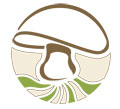Newtown Common
Sun 14 Aug 2005
Field event ID HF0507
OS Grid areas: SU4763
Report: The 14th August found Alan Lucas, Sue Rogerson, Eric Janke, Mark Hampton and Stuart Skeates foraying in the northern perimeter of Hampshire at Newtown and Burghclere Common in fine weather with just a threat of a shower. The foray, led by Eric, started with early excitement as Boletus porosporus (microscopically confirmed later) and Amanita fulva were found near the car park before we set off. The good fortune continued with a steady trickle of fungi growing from soil for the first time this summer; it was good to see boletes and russulas appearing again. A fresh fruitbody of Heterobasidium annosum was found growing on this occasion on beech rather than it's more usual conifer host. Shortly after, foraying around the rim of an overgrown pit, some old hynoid bodies were found and after more diligent searching Eric located a small fresh fruitbody which Alan thought to be Hydnellum spongiosipes. We moved from the birch pine heathland area to an alder carr just prior to lunch where various challenging small fruitbodies were taken for later identification, one of which was Lactarius obscuratus. Whilst most of us were enjoying lunch Alan, not wishing to waste any time, returned to the bog only to emerge shortly after with small white mycena on an alder cone. Mark immediately recognised the fungus from it's habitat as M rhenana and the description in Courtecuisse fitted perfectly. A quick check on the BMS database, over a mobile phone internet connection, showed there to be only one British collection. This fact saw the group quickly finish lunch and scurry back into the bog searching for further fruitbodies which were later sent to Kew and shown to Ern Emmett at the BMS Autumn Foray. We returned to the car park over the heath in glorious sunshine in high spirits after a rewarding foray.
Species list: Amanita fulva, Amanita phalloides, Amanita rubescens, Annulohypoxylon multiforme, Bjerkandera adusta, Boletus badius, Boletus edulis, Boletus porosporus, Cantharellus cibarius, Chlorociboria aeruginascens, Crepidotus variabilis, Cudoniella acicularis, Diatrype disciformis, Exidia nucleata, Fuscoporia ferrea, Ganoderma australe, Gymnopus peronatus, Heterobasidion annosum, Hydnellum spongiosipes, Hymenochaete corrugata, Hymenochaete rubiginosa, Hyphodontia subalutacea, Hypoxylon rubiginosum, Ischnoderma benzoinum, Lactarius obscuratus, Marasmiellus vaillantii, Marasmius rotula, Megacollybia platyphylla, Mensularia radiata, Mucronella flava, Mycena acicula, Mycena rhenana, Mycoacia uda, Paxillus involutus, Phanerochaete velutina, Phlebia rufa, Phlebiella sulphurea, Physisporinus sanguinolentus, Piptoporus betulinus, Pluteus cervinus, Pluteus podospileus, Rhodocollybia butyracea, Rickenella fibula, Rickenella swartzii, Russula alnetorum, Russula claroflava, Russula grisea, Russula nobilis, Russula ochroleuca, Russula parazurea, Schizopora paradoxa, Scleroderma citrinum, Skeletocutis nivea, Stereum hirsutum, Stereum rameale, Trichoderma pulvinatum, Vuilleminia comedens, Xylaria carpophila
